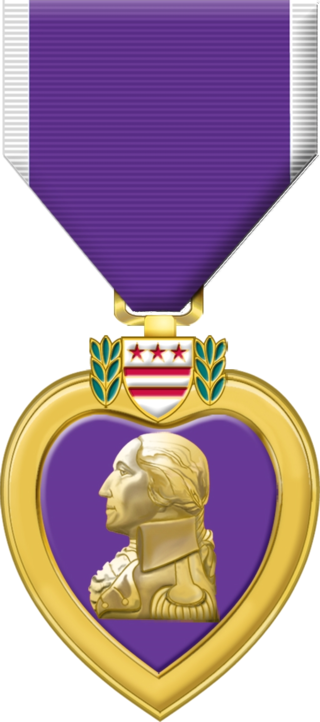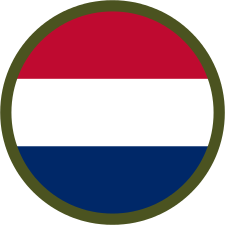
The Purple Heart (PH) is a United States military decoration awarded in the name of the president to those wounded or killed while serving, on or after 5 April 1917, with the U.S. military. With its forerunner, the Badge of Military Merit, which took the form of a heart made of purple cloth, the Purple Heart is the oldest military award still given to U.S. military members. The National Purple Heart Hall of Honor is located in New Windsor, New York.

The total number of military and civilian casualties in World War I was about 40 million: estimates range from around 15 to 22 million deaths and about 23 million wounded military personnel, ranking it among the deadliest conflicts in human history.
Corps is a term used for several different kinds of organization. A military innovation by Napoleon I, the formation was first named as such in 1805. The size of a corps varies greatly, but two to five divisions and anywhere from 40,000 to 80,000 are the numbers stated by the US Department of Defense.

The II Corps was a corps-sized formation of the United States Army that was active in both World War I and World War II. It was originally formed and fought on the Western Front during World War I and was also the first American formation of any size to see combat in North Africa or Europe during World War II.
The British Expeditionary Force (BEF) was the six divisions the British Army sent to the Western Front during the First World War. Planning for a British Expeditionary Force began with the 1906–1912 Haldane Reforms of the British Army carried out by the Secretary of State for War Richard Haldane following the Second Boer War (1899–1902).

The American Expeditionary Forces (AEF) was a formation of the United States Armed Forces on the Western Front during World War I, composed mostly of units from the U.S. Army. The AEF was established on July 5, 1917, in France under the command of then-Major General John J. Pershing. It fought alongside French Army, British Army, Canadian Army, British Indian Army, New Zealand Army and Australian Army units against the Imperial German Army. A small number of AEF troops also fought alongside Italian Army units in 1918 against the Austro-Hungarian Army. The AEF helped the French Army on the Western Front during the Aisne Offensive in the summer of 1918, and fought its major actions in the Battle of Saint-Mihiel and the Meuse-Argonne Offensive in the latter part of 1918.

The Croix de Guerre is a military decoration of France. It was first created in 1915 and consists of a square-cross medal on two crossed swords, hanging from a ribbon with various degree pins. The decoration was first awarded during World War I, again in World War II, and in other conflicts; the croix de guerre des théâtres d'opérations extérieures was established in 1921 for these. The Croix de Guerre was also commonly bestowed on foreign military forces allied to France.

The First Australian Imperial Force was the main expeditionary force of the Australian Army during the First World War. It was formed as the Australian Imperial Force (AIF) following Britain's declaration of war on Germany on 15 August 1914, with an initial strength of one infantry division and one light horse brigade. The infantry division subsequently fought at Gallipoli between April and December 1915, with a newly raised second division, as well as three light horse brigades, reinforcing the committed units.

The Distinguished Service Cross (DSC) is the United States Army's second highest military decoration for soldiers who display extraordinary heroism in combat with an armed enemy force. Actions that merit the Distinguished Service Cross must be of such a high degree that they are above those required for all other U.S. combat decorations, but which do not meet the criteria for the Medal of Honor. The Army Distinguished Service Cross is equivalent to the Naval Services' Navy Cross, the Air and Space Forces' Air Force Cross, and the Coast Guard Cross. Prior to the creation of the Air Force Cross in 1960, airmen were awarded the Distinguished Service Cross.

The Indian Army during British rule, also referred to as the British Indian Army, was the main military force of the British Indian Empire until Indian independence in 1947. It was responsible for the defence of both British India and the princely states, which could also have their own armies. As quoted in the Imperial Gazetteer of India, "The British Government has undertaken to protect the dominions of the Native princes from invasion and even from rebellion within: its army is organized for the defence not merely of British India, but of all possessions under the suzerainty of the King-Emperor." The Indian Army was an important part of the forces of the British Empire, in India and abroad, particularly during the First World War and the Second World War.

The 33rd Infantry Division was a formation of the U.S. Army National Guard between 1917 and 1968. Originally formed for service during World War I, the division fought along the Western Front during the Battle of Amiens, the Battle of Hamel, the Meuse-Argonne Offensive, at the Second Battle of the Somme, and at the Battle of Saint-Mihiel. It was re-formed during the inter-war period, and then later activated for service during World War II, seeing action against the Imperial Japanese Army in the Pacific. In the post war era, the division was reconstituted as an all-Illinois National Guard division. In the late 1960s, the division was reduced to a brigade-sized formation, and its lineage is currently perpetuated by the 33rd Infantry Brigade Combat Team.

The Australian and New Zealand Army Corps (ANZAC) was originally a First World War army corps of the Mediterranean Expeditionary Force. It was formed in Egypt in December 1914, and operated during the Gallipoli campaign. General William Birdwood commanded the corps, which primarily consisted of troops from the First Australian Imperial Force and 1st New Zealand Expeditionary Force, although there were also British and Indian units attached at times throughout the campaign. The corps disbanded in 1916, following the Allied evacuation of the Gallipoli peninsula and the formation of I ANZAC Corps and II ANZAC Corps. The corps was re-established, briefly, in the Second World War during the Battle of Greece in 1941. The term 'ANZAC' has been used since for joint Australian–New Zealand units of different sizes.

The Military Medal (MM) was a military decoration awarded to personnel of the British Army and other arms of the armed forces, and to personnel of other Commonwealth countries, below commissioned rank, for bravery in battle on land. The award was established in 1916, with retrospective application to 1914, and was awarded to other ranks for "acts of gallantry and devotion to duty under fire". The award was discontinued in 1993, when it was replaced by the Military Cross, which was extended to all ranks, while other Commonwealth nations instituted their own award systems in the post war period.

The Battle of Épehy was fought during the First World War on 18 September 1918, involving the British Fourth Army under the command of General Henry Rawlinson against German outpost positions in front of the Hindenburg Line. The village of Épehy was captured on 18 September by the 12th (Eastern) Division.

Fort Sam Houston National Cemetery is a United States National Cemetery in San Antonio, Texas. Administered by the United States Department of Veterans Affairs, it encompasses 154.7 acres (62.6 ha), and as of 2014, had over 144,000 interments. The cemetery was listed on the National Register of Historic Places in 2016.

The military history of Canada during World War I began on August 4, 1914, when the United Kingdom entered the First World War (1914–1918) by declaring war on Germany. The British declaration of war automatically brought Canada into the war, because of Canada's legal status as a British Dominion which left foreign policy decisions in the hands of the British parliament. However, the Canadian government had the freedom to determine the country's level of involvement in the war. On August 4, 1914, the Governor General declared a war between Canada and Germany. The Militia was not mobilized and instead an independent Canadian Expeditionary Force was raised.

13th Corps was a corps-sized formation of the British Army that fought on the Western Front during the First World War and was reformed for service during the Second World War, serving in the Mediterranean and Middle East throughout its service.

The following events occurred in September 1918:















